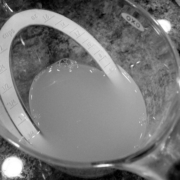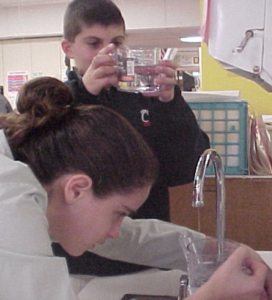Alex Lee, longtime president of OXO, the maker of well-designed cooking tools and housewares, told the story of how they created their iconic liquid measuring cup.
No one had ever seriously complained about measuring cups. Some people thought that glass ones are too heavy and that they tend to break, but that was really it. OXO started to study how consumers use measuring cups and noticed one striking commonality that was more impactful. It’s something you’ve probably done yourself at some point.
Photo source: http://www.cas.muohio.edu/scienceforohio/Jello/L.html
Do you see it? Using a traditional liquid measuring cup, you need to lean over to read the measurement. It’s annoying, But we thought it was normal. Well, we did think it was normal until OXO designed a better way: a measuring cup you can read from the top, with no leaning over required.
Photo source: http://flickr.com/photos/jisou/512193478/
This new measuring cup sold two million units (!) in the first year.
This is a powerful idea: studying how consumers behave can transform your business. I apply this maxim to pricing research, a topic that has been popular with a number of my clients.
When thinking about how to suggest a retail price, many brands, both big and small, start with their cost. Then they add on the profit they want to earn, account for expected distributor and retail margins, and get to a suggested retail price. Or someone suggests a key price in their category and they go with that.
But it’s critical to take the consumer’s point of view into account and understand her willingness-to-pay.
There are three approaches I rely on:
- Engage with your retailer’s buying team
- Observe what’s happening in the market
- Use surveys to ask consumers about price directly
1. Engage with your retailer’s buying team
The team at your retailer customers might have some research or other experience in understanding their shoppers’ willingness-to-pay. Ask them. When you have a review meeting or some other opportunity to talk, ask what they are hearing. Keep in mind, though, that many buyers are biased toward always lowering prices, even if it means that they lose penny profit.
One client of mine faced significant cost pressure, but the client’s largest customer simply would not accept a price increase. We probed to understand her resistance, and she showed evidence that products in her portfolio suffered large declines in velocity when they were priced above $1.99. We suggested a smaller pack size that could hit the magic $1.99 price point and make money for my client. She accepted the proposal, and this arrangement worked for everyone.
2. Observe what’s happening in the market
Competitive benchmarking: Where are your competitors priced, and where do you fit on the continuum? Are you priced comparably to competitors whose products realistically compare to yours? Are there any magic prices that are working well or toxic prices that are failing miserably?
Natural elasticity: if your product sells at different prices at different retailers during different weeks, or at a discount during a price reduction, measure the effects. Equivalize sales across retailers by measuring units sold per store per week (or per million dollars of store ACV), and see if one price works much better than another. For a frozen food item, I once found that promoting it at $2.49 produced better unit movement than at $2.29. It was a no-brainer to make the change. You can obtain this data directly from your retailer customers or from syndicated data sources like SPINS, IRI, and Nielsen.
3. Use surveys to ask consumers directly about price
There is a wide range of tools available to affordably survey consumers about their willingness to pay for your items and other topics. I have found Google Surveys to be very affordable for certain use cases, as low as 10 cents per response for a single-question survey.
From easiest to hardest, some pricing survey techniques include:
- Gabor Granger: Identify the highest acceptable price by asking about purchase intent at multiple price points.
- Van Westendorp: Identify bounds of acceptable price ranges by asking what prices would be too cheap, cheap, expensive, and too expensive.
- Conjoint: Identify utilities of product attributes, including price, by having respondents choose from among multiple product/price combinations.
* * *
Ultimately, the most important thing is to get inside your consumers’ heads. Any technique you use to get there will involve a wide range of trade-offs, but it’s important to start somewhere. And the evidence you learn to support your objectives will go a long way toward building trust with your retail buyers, sales team, and beyond.
(You can see a video of Alex Lee’s presentation that inspired me on the Gel Conference’s Vimeo channel.)
Contact Scott if you’d like help thinking about your products’ prices — and how your customers perceive them.
A version of this post originally appeared in Specialty Food Resource’s Food Entrepreneur Magazine.






